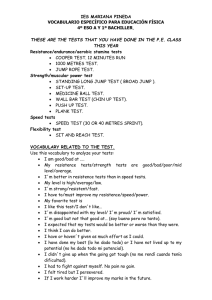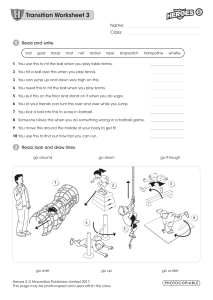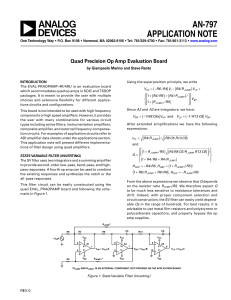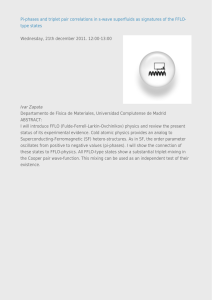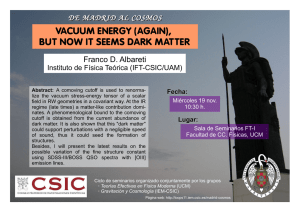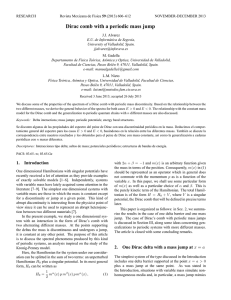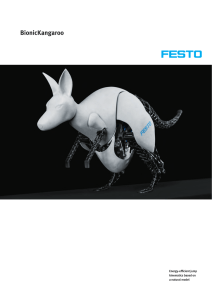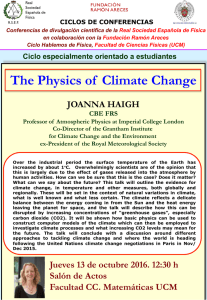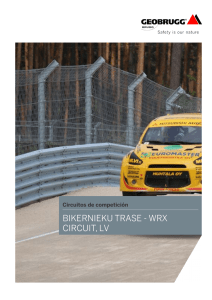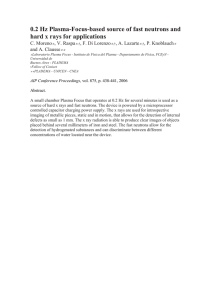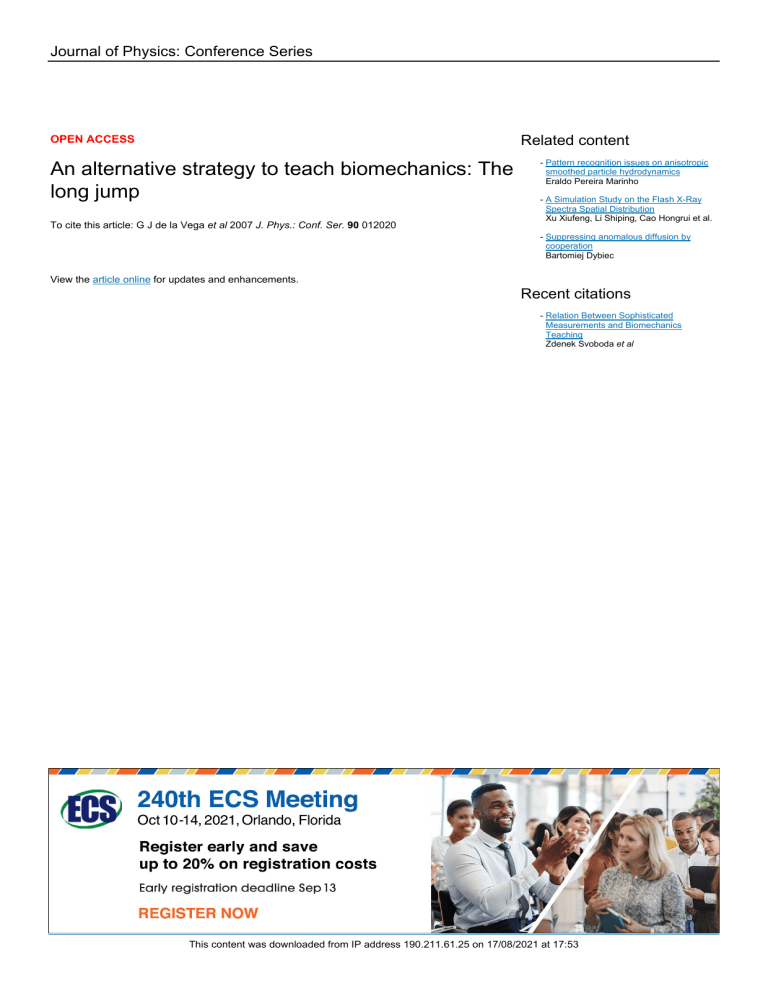
Journal of Physics: Conference Series Related content OPEN ACCESS An alternative strategy to teach biomechanics: The long jump To cite this article: G J de la Vega et al 2007 J. Phys.: Conf. Ser. 90 012020 - Pattern recognition issues on anisotropic smoothed particle hydrodynamics Eraldo Pereira Marinho - A Simulation Study on the Flash X-Ray Spectra Spatial Distribution Xu Xiufeng, Li Shiping, Cao Hongrui et al. - Suppressing anomalous diffusion by cooperation Bartomiej Dybiec View the article online for updates and enhancements. Recent citations - Relation Between Sophisticated Measurements and Biomechanics Teaching Zdenek Svoboda et al This content was downloaded from IP address 190.211.61.25 on 17/08/2021 at 17:53 16th Argentine Bioengineering Congress and the 5th Conference of Clinical Engineering IOP Publishing Journal of Physics: Conference Series 90 (2007) 012020 doi:10.1088/1742-6596/90/1/012020 An alternative strategy to teach Biomechanics: The long jump G J de la Vega1, J A Aguilera1, A E Puzzella1 2 and C C Mallamaci1 3 1 School of Exactly, Physical and Naturals Science. I de la Roza 590 (Oeste). CP 5413. San Juan. Argentina. 2 Institute of Investigation at Education at Experimental Sciences, IIECE, School of Philosophy, Humanities and Arts. National University of San Juan. I de la Roza 230 (Oeste). CP 5400. San Juan. Argentina. 3 School of Philosophy, Humanities and Arts. National University of San Juan. I de la Roza 230 (Oeste). CP 5400. San Juan. Argentina. E-mail: [email protected], [email protected] Abstract. The work develops an alternative methodology to teach the Physics principles of Parabolic Cannon Shot in the career of Bioengineering using instead the physic-biological relationship of the long jump performed in Athletics. This is a closer-to-reality example for this discipline, and it is a field- and computer laboratory-reproducible practice that is simple to do by using affordable technology, because the practice can be filmed by the students in a real setting for future analysis off classroom hours. The data extracted from the film can be analysed and used to learn the physics of motion of the participating athletes, and to draw conclusions from their hands-on experience. As a main factor of the proposal, this latter characteristic aims at motivating the students to work and participate within a collaborative framework, so as to motivate them to reason and respond the questionnaire issues that stems from a real experience. A significant improvement of knowledge transference is thus attained by promoting teaching (and self-teaching) through reality-based perception, analysis and learning). This work is undergoing its first stage, and its conclusions arise from the observations on team-work dynamics. Quantitative results are expected for the following stages which are under way of execution. Keywords —alternative strategy, biomechanics, long jump, field and laboratory practice, meaningful learning. 1. Introduction During recent decades, the field of educational research has developed a significant number or works on teaching Natural Science. This profusion of varied studies describes numerous pedagogical activities and techniques to teach Physics [1]. At university level, the teaching practice is focused on conceptual contents, following traditional methodologies to develop the theoretical, practical and experimental aspects. The importance of laboratory practice lies on assisting the students not only to develop their capability on variable controlling, instrumentation handling, data analysis, and like abilities, but also to render their laboratory practices a quality as “small collective research”, as an approach to scientific task [2]. Besides, by means of team (collaborative) learning, the students are capable of reaching goals linked to skill development that foster overall learning throughout a lifetime [3], [4]. c 2007 IOP Publishing Ltd 1 16th Argentine Bioengineering Congress and the 5th Conference of Clinical Engineering IOP Publishing Journal of Physics: Conference Series 90 (2007) 012020 doi:10.1088/1742-6596/90/1/012020 The subject of Physics within a Biology context creates an incontestable potential to develop skills that may benefit the learning proficiency of scientific concepts. Physical phenomena are workable through mathematical formalization that typically entail different variables –some of which are controllable and other are fixed, in order to simplify and model reality. Due to their intrinsic complexity, biologic systems “… cannot be characterized by just a few parameters …” [5]. Within this context, live beings —hence, human beings as well— are part of this physical world and, as such, cannot escape from being subjected to the laws that rule the real world. [5] The “targets for the Introductory Physics Laboratories” set by the American Association of Physics Teachers (AATP) define that “Physics is an experimental science; and that observation and experimentation are as equally important as theory and concepts”. Said targets are: • The art of experimentation • Experimental and analytical skills • Conceptual learning • Understanding the knowledge foundations of Physics • Developing personal skills from team work In recent years, the problems of learning Science have caused an increase of student dropout and relented coursing of students of basic school years, especially in Physics courses. From among the various factors linked to this issue, the deficiency as regards basic-and-general skill acquisition (attitudes and values) needed for efficient academic performance is predominant. [3], [6] How to approach the integration of Physics and Biology by using the laboratory in a real and contextualized instance? The response to this question may also be found on Biomechanics, because the motion of biological systems (a man, in this case) can be studied through Mechanics. The current work, that focuses on an alternative strategy to achieve a meaningful learning level of Kinematics, sets a potential to the straightforward application of Physical concepts —both to daily life instances and to sports, on high-performance exercises. Specifically, the work analyses the motion of bodies (as in parabolic cannon-projectile firing). By leaving aside the old examples, that are scarcely motivating for the student, and by incorporating theoretical-practical field exercises, as is the case of the long jump, the problem can be made easier to understand and, at the same time, create motivation to the student. That is, the theoretical concepts can be duplicated by the students in field practices that can be accommodated off the class time. From this standpoint, the problems of “hard sciences” become tangible and applicable into our environment. It also encourages teamwork and meaningful learning by part of the students. 2. Methodology The proposed strategy to teach Kinematics is based on solving a definite problem. In contrast to the classic examples used in teaching “Parabolic Cannonball Shot”, the work develops a field-laboratory experience based on reality: the Long Jump or Leap Forward. This practice promotes both the student’s motivation (who is given the leading role) and the team work, in order to attain results and conclusions. 2.1. Context The Practice is mainly contextualized in a real setting, as is the case of long jump practice at the athletic tracks of the Sports Field of Universidad Nacional de San Juan. 2.2. Resources On these regards, it is important to mention two necessary and complementary resources: 2 16th Argentine Bioengineering Congress and the 5th Conference of Clinical Engineering IOP Publishing Journal of Physics: Conference Series 90 (2007) 012020 doi:10.1088/1742-6596/90/1/012020 2.2.1 Materials Metering winch tape. Chronometer. Angle-metering demi-circle. Color-contrasting belt or strip. Digital video camera (minimum rate: 15 frames per second). Tripod or base to hold the camera. Scale markers (indicators). Computer with software to translate from “*.AVI” format into “*.MOV” and image editor. TV set with DVD player, and/or multimedia screen-projection set, for a master class if required. 2.2.2 Human resources 4-student teams, with participant roles as: leap performer (leaper). Camera man. Chronometer recorder. Jump referee. 2.2.3 Procedure 2.2.3.1. Preparation of field setting First, the camera should be installed and mounted in a way that the total jump range (with previous running and leap) can be captured and focused correctly, following the resemblance to the cannon-ball trajectory counterpart. The camera used in the experience is a Sony Cyber-Shot CAM-corder, Model DSCH1. As regards the leap performer, s/he shall wear light clothing of dark color so as to attach a reference dot or mark –the reference center or c.r.- placed on the waist. Intended for a better visual reference for leap trajectory description, this marking element must be a brightly colored belt (yellow, fuchsia, etc) that strikingly contrasts with the surrounds and background tones. The referential point was chosen on the waist because this is the part of the body that allows clearly seeing a parabolic trajectory in a long jump, as opposed to arms, legs and head, which govern the motion of height jump. Other referential points should be also placed on some of the track axes, particularly stakes or real objects of known length, so as to help determine the corresponding scale conversions of the recorded material (real setting –film). 2.2.3.2 Theoretical analysis of the jump (leap) On figure 1, a diagram shows the intervening variables of the long jump. The jump has many aspects to analyze, but in order to collect true record data, it shall be broken down into the various stages: D1, D2, D3, D4 and Dtotal. In figure 1 the entire parabolic cannonball shot is shown completely. From this trajectory, only D2 is the segment that is useful for the study. The remaining curve segments, their distances and measurements have to be explained with additional Physical concepts, because these trajectory stretches are not easily measurable with the current equipment. This data, nevertheless, will not be needed for the analysis, because their results depend more likely on the individual jumping technique of each leaper rather than on the Physics rationale. 2.2.3.2. Gathering of experimental data Here the subject (a student) does a 20m horizontal run; he is timed by another student to determine the horizontal speed up to the springboard and jump start. Upon finishing the long leap, the jump referee will measure the length covered by the jump. Filming should begin altogether with the starting run of the subject. By watching the recorded video and using pauses, the positions of the referential point (c.r.) are marked so as to build the trajectory. This line is drawn by the students on the whiteboard where the projected image is seen; or –else- it can be drawn on transparent slide film sheet placed on the PC monitor screen, or –finally- a TV set screen. Then, with an angle meter demi-circle, the jumping angle 3 16th Argentine Bioengineering Congress and the 5th Conference of Clinical Engineering IOP Publishing Journal of Physics: Conference Series 90 (2007) 012020 doi:10.1088/1742-6596/90/1/012020 shall be found. Using the referential scales, the students will be guided to obtain and correct the field and laboratory collected data. G Figure 1. Theoretical diagram of the long jump. At this v i : referential center velocity; h.c.r.: height of the referential center; maximum height of the c.r.; a: jump angle; D1: distance between the distal edge of the digital support of the leaping foot and the vertically projected line of the c.r. at the starting time of leap (flight); D2: distance between the vertically projected line of the c.r. at the starting moment of jump (leap) (parallel to the previous line) and the point at which the c.g. (center of gravity) reaches again the height h.c.r. that it had at the beginning of the jump (flight); D3: distance between the final point of D2 and the projecting line of the cg at the time where the heels touch the sand to begin the damping action for the jump; D4: distance between D3 and the fall footprint on the jumping bed; Dtotal; summation of D1, D2, D3, and D4, which defines the total real length of the jump. In order to achieve statistically significant experimental results it is important to count with data from as many jumps as possible, with a minimum number of three jumps per leaper. This amount of data allows finding average and standard error values on leaper speed, jump height, maximum height of the reference point and jump angle. Upon making the direct and indirect measurements, the students have to complete Table I, using the formula and theoretical concepts that were previously worked upon. Once the video recordings are developed, the students have to process the images in order to find the data corresponding to the series of jumps performed. A minimum of three jumps per leaper shall be worked on in order to apply the basic statistical tools of Average and Variance, on the data of speed, jump length, maximum height of the reference point and jump angles. Table 1. Format of the table the students have to fill with the data from experiences Leaper Nº. of jump 1 1 2 3 1 2 3 ... 2 N Arrival time at the jumping board (s) Jump length Maximum height of the c.r Initial angle On Trajectory D2, on figure 1, we shall analyze the angle developed in the leap, and the gravity center speed. The trajectory generated by the reference mark shall be recorded by the students, either on the whiteboard images from the projectors or on the slides projections on the PC monitor screens or TV set. The methodology is to graphically record the trajectory points after pausing the images for each jump. Then, with an angle meter, the jump angle is measured. Using reference scales, the students shall be guided to correct the data attained in the laboratory. 4 16th Argentine Bioengineering Congress and the 5th Conference of Clinical Engineering IOP Publishing Journal of Physics: Conference Series 90 (2007) 012020 doi:10.1088/1742-6596/90/1/012020 With all the data gathered in the laboratory, the students will be able to make comparisons between the anatomical relationships of leapers (height of the reference mark), the arrival speed at the springing leap point and the leap distances covered. They can also modify these variables in order to get new and optimal results. This way, the students will be capable of elaborating their own theory and draw conclusions on jump mechanics, so as to arrange discussion among themselves on their findings. As a corollary, it can be stated that a physical phenomenon has been thoroughly understood when the subject is capable of identifying such phenomenon within the pertaining discipline, recognizing the intervening variables, describing the operational mechanics of the physical system, interpreting the results attained, and elaborating a well-organized and firmly based expository presentation of a given conceptual content [4]. 3. Conclusions In order to present its results and conclusions, this work has been based on qualitative data obtained from classroom observations. This is so because the presentation deadline for the written reports completed by the students was a future date to the deadline established for work presentations at SABI 2007. From observations made in the field and classroom-laboratory, the alternative strategy proposed to teach the Physics of the Parabolic Shot, the long jump experience performed in real time has demonstrated the importance of incorporating this kind of teaching activity in the current syllabus of Physics for Bioengineering. The rationale for this lies on the great motivation shown by the participant students, their improved capability for questioning and reasoning, and the visible commitment put forth in field and classroom activities and, moreover, in the recursive office-hour consultation made by the involved students. On the other hand, team work was emphasized through dynamic collaboration among all team members so as to solve satisfactorily the problem presented. In addition, this work alternative promotes a stronger personal involvement that results in feelings of achievement and self-esteem for current and future academic tasks. References [1] Benito A, Portela A and Rodríguez M R 2006 Análisis de la enseñanza de la Física en Europa: el fomento de competencias generales en estudiantes universitarios. Universidad Europea de Madrid España. Revista Iberoamericana de Educación. 38/7. On line, http://www.oei.es/oeivirt/enfisica.htm. [2] Pozo J I and Gómez Crespo M A 1998 Aprender y Enseñar Ciencias. Del conocimiento cotidiano al conocimiento científico Ediciones Morata España. [1] Zalba E et al. 2005 Competencias para el Ingreso y Permanencia en la universidad: Una propuesta para la Articulación Curricular entre el Nivel Superior y el Nivel Medio de enseñanza. In Seminar Proceedings: Currículo Universitario basado en Competencias. 25 and 26 July 2005 Universidad del Norte Barranquilla Colombia. On line on 10 /03/2006 at http://www.ts.ucr.ac.cr/ /mod-cole/boletin-esociales-1.htm [4] Sampallo G and Mezza E 2005 El uso de la Cámara digital para la obtención de datos en Física. In XIV Reunión Nacional de Educación en la Física (REF XIV) Río Negro Argentina. [5] Cussó F, López C and Villar R 2004 Física de los Procesos Biológicos Ariel Barcelona España. [6] Puzzella A, Lopez N y Alborch A 2005 Las actitudes de los alumnos universitarios. Una indagación exploratoria. In XIV Reunión Nacional de Educación en la Física (REF XIV), Río Negro Argentina. [7] Sears F, Zemansky M, Young H and Freedman R 2005 Física Universitaria Undécima Edición Vol 1 Pearson Educación S. A. México. [8] Cromer A 1992 Física para las ciencias de la vida Reverté S. A. Barcelona España. 5
